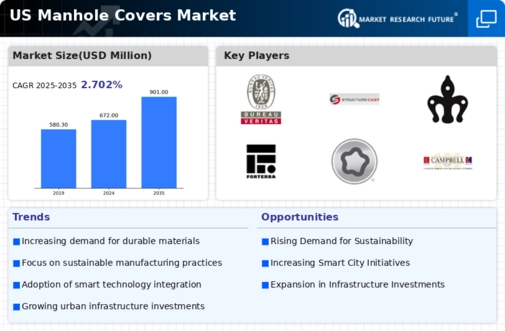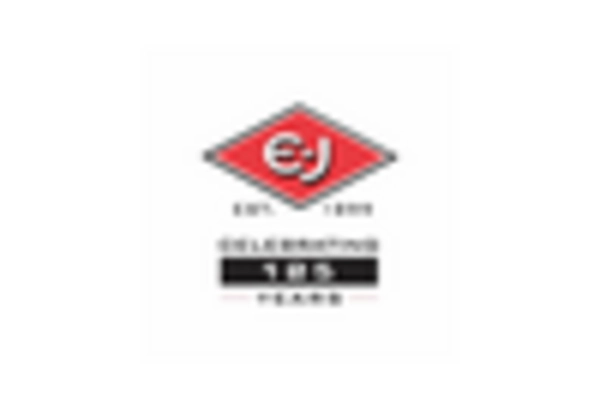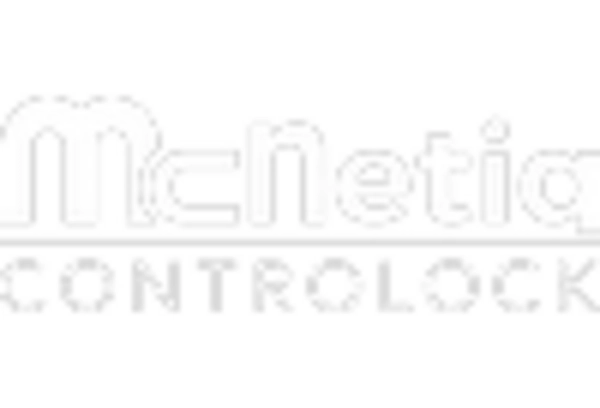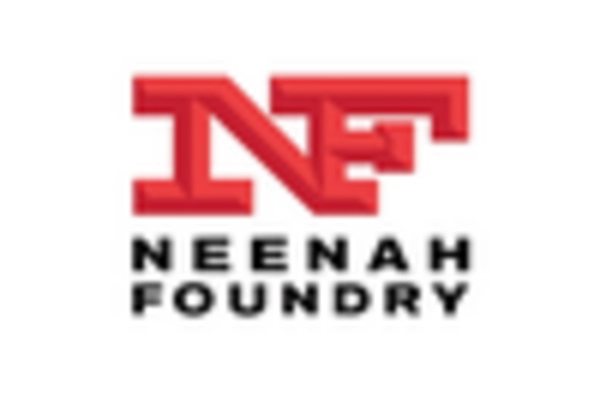Urban Infrastructure Development
The ongoing expansion and modernization of urban infrastructure in the US appears to be a primary driver for the manhole covers market. As cities grow and evolve, the demand for durable and reliable manhole covers increases. In 2025, the urban infrastructure sector is projected to reach a valuation of approximately $1 trillion, with a significant portion allocated to public utilities and transportation systems. This growth necessitates the installation of high-quality manhole covers to ensure safety and functionality. Furthermore, the trend towards smart city initiatives may lead to increased investments in infrastructure, further boosting the manhole covers market. The integration of advanced materials and designs in manhole covers is likely to enhance their performance, thereby attracting more investments in this sector.
Rising Maintenance and Repair Needs
The aging infrastructure in many US cities has led to a heightened focus on maintenance and repair, which significantly impacts the manhole covers market. As existing manhole covers deteriorate, municipalities are compelled to replace them to maintain safety and accessibility. Reports indicate that approximately 30% of manhole covers in urban areas require immediate attention due to wear and tear. This situation creates a robust demand for new manhole covers, particularly those that offer enhanced durability and longevity. Additionally, the increasing frequency of inspections and maintenance activities suggests that the manhole covers market will continue to thrive as cities prioritize infrastructure upkeep. The emphasis on reliable and resilient products is likely to shape purchasing decisions in the industry.
Environmental Regulations and Standards
The increasing emphasis on environmental regulations in the US is likely to influence the manhole covers market significantly. Stricter guidelines regarding material usage and waste management are compelling manufacturers to adopt eco-friendly practices. The market is witnessing a shift towards sustainable materials. An estimated 25% of new manhole covers are expected to be produced from recycled materials by 2025. Compliance with these regulations not only enhances the market's reputation but also opens up new opportunities for manufacturers to innovate. As cities strive to meet sustainability goals, the demand for environmentally friendly manhole covers is expected to rise, thereby shaping the future of the industry. This trend indicates a growing awareness of the environmental impact of infrastructure components.
Increased Investment in Public Utilities
Investment in public utilities is a crucial driver for the manhole covers market. As governments allocate more funds to improve water, sewage, and electrical systems, the demand for reliable manhole covers is likely to increase. In 2025, public utility investments are projected to exceed $200 billion, with a substantial portion directed towards infrastructure upgrades. This influx of capital may lead to the replacement of outdated manhole covers with modern alternatives that offer enhanced safety and efficiency. Furthermore, the focus on improving public services suggests that the manhole covers market will benefit from increased procurement activities. The alignment of public utility investments with infrastructure needs indicates a promising outlook for the industry.
Technological Advancements in Manufacturing
Technological innovations in manufacturing processes are poised to transform the manhole covers market. The adoption of advanced materials and production techniques, such as 3D printing and composite materials, may lead to the creation of lighter yet stronger manhole covers. These advancements could potentially reduce production costs and improve product performance. In 2025, the market for advanced manufacturing technologies is expected to grow by approximately 15%, indicating a shift towards more efficient production methods. As manufacturers embrace these technologies, the manhole covers market may witness a surge in demand for innovative products that meet the evolving needs of urban planners and engineers. This trend suggests a competitive landscape where quality and efficiency become paramount.

















Leave a Comment